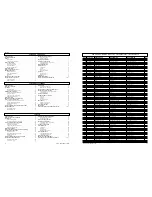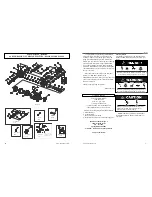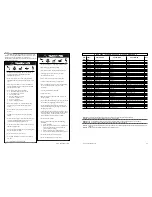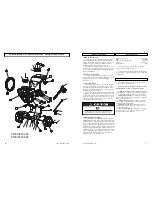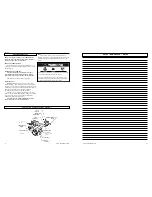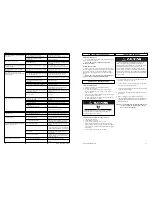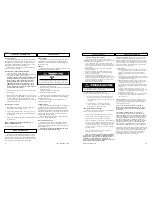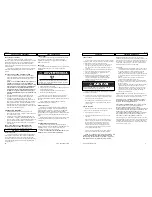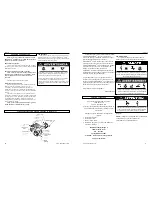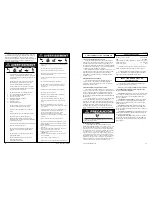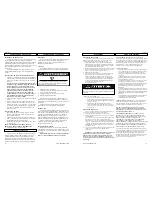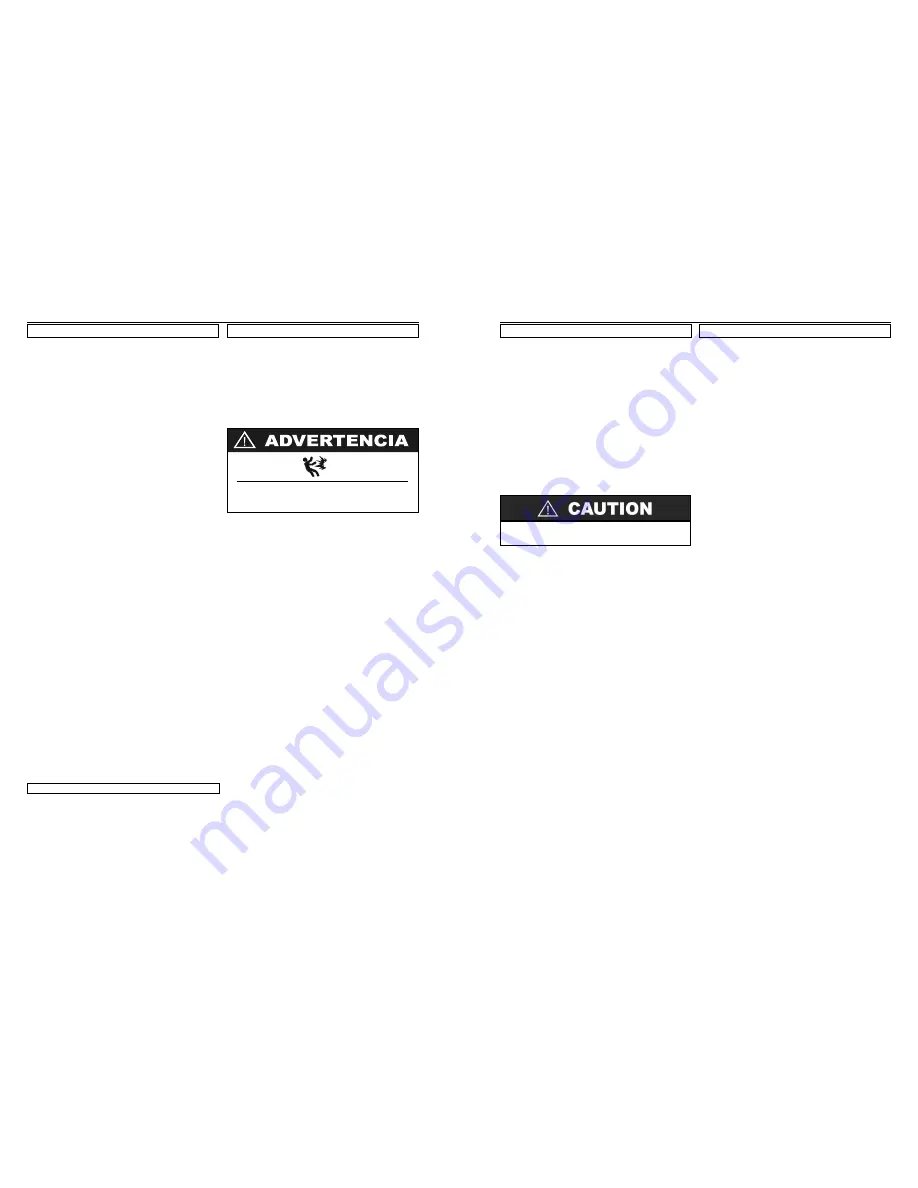
PUMP STORAGE
If you must store your pressure washer in a location where the
temperature is below 32°F, you can minimize the chance of damage
to your machine by utilizing the following procedure:
1.
Shut off water supply and relieve pressure in the spray gun
by depressing the trigger. Disconnect the garden hose
from the pressure washer, but leave the high-pressure hose
connected.
2.
Tip the unit on its side with the inlet connection pointing up.
3.
Insert a small funnel (to prevent spilling) into the inlet
and pour in approximately 1/4 cup of RV antifreeze.
4.
Disconnect spark plug wire.
5.
Without connecting garden hose pull the recoil several
times to circulate the antifreeze in the pump system.
Continue to add antifreeze and pull the recoil until the
antifreeze is expelled when the trigger is pulled.
6.
Turn the unit upright.
Another method of reducing risks of freeze damage is to drain
your pressure washer as follow:
1.
Stop the pressure washer and detach supply hose and high
pressure hose. Squeeze the trigger of the discharge gun to
drain all water from the wand and hose.
2.
Restart the pressure washer and let it run briefly (about 5
seconds) until water no longer discharges from the high
pressure outlet.
ENGINE STORAGE
When the pressure washer is not being operated or is being
stored more than one month, follow these instructions:
1.
Replenish engine oil to upper level.
2.
Drain gasoline from fuel tank, fuel line, fuel valve and
carburetor.
3.
Pour about one teaspoon of engine oil through the spark
plug hole, pull the recoil starter several times and replace
the plug. Then pull the starter slowly until you feel
increased pressure which indicates the piston is on its
compression stroke and leave it in that position. This
closes both the intake and exhaust valves to prevent the
inside of the cylinder from rusting.
4.
Cover the pressure washer and store in a clean, dry place
that is well ventilated away from open flame or sparks.
NOTE: We recommend always using a fuel stabilizer. A fuel
stabilizer will minimize the formulation of fuel gum deposits
during storage. The fuel stabilizer can be added to the gasoline
in the fuel tank, or into the gasoline in a storage container.
Warranty Coverage:
MAT Industries, LLC (the Company)
warrants to the original retail customer in North America that it will
repair or replace, free of charge, any parts found by the Company or
its authorized service representative to be defective in material or
workmanship. This warranty covers the cost of replacement parts
and labor for defects in material or workmanship.
Not Covered:
·
Transportation charges for sending the product to the Company
or its authorized service representative for warranty service, or
for shipping repaired or replacement products back to the
customer; these charges must be borne by the customer.
·
Engine may be covered exclusively by a separate warranty from
the engine manufacturer as set forth in the engine Manual (if
included).
·
Damages caused by abuse or accident, and the effects of
corrosion, erosion and normal wear and tear.
·
Warranty is void if the customer fails to maintain and operate
the product as instructed and recommended by the Company in
the owner's manual.
·
Warranty applies only if the product is used solely for consumer
applications, and does not apply if the product is used for
commercial or business applications, or as rental equipment.
·
The Company will not pay for repairs or adjustments to the
product, or for any costs or labor, performed without the
Company's prior authorization.
Warranty Period:
One (1) year from the date of purchase. For
warranty service, the customer must provide dated proof of purchase
and must notify the Company within the warranty period.
For warranty service: Call toll free 888-895-4549, or write to
Sanborn Manufacturing Co., Product Services, 118 West Rock
Street, P. O. Box 206, Springfield, MN 56087.
EXCLUSIONS AND LIMITATIONS:
THE COMPANY MAKES
NO OTHER WARRANTY OF ANY KIND, EXPRESS OR
IMPLIED. IMPLIED WARRANTIES, INCLUDING
WARRANTIES OF MERCHANTABILITY AND OF FITNESS FOR
A PARTICULAR PURPOSE, ARE HEREBY DISCLAIMED. THE
WARRANTY SERVICE DESCRIBED ABOVE IS THE
EXCLUSIVE REMEDY UNDER THIS WARRANTY; LIABILITY
FOR INCIDENTAL AND CONSEQUENTIAL DAMAGES IS
EXCLUDED TO THE EXTENT PERMITTED BY LAW.
This warranty gives you specific legal rights, and you may also have
other rights which vary from state to state. Some states do not allow
a disclaimer of implied warranties, or the exclusion or limitation of
incidental and consequential damages, so the above disclaimers and
exclusions may not apply to you.
Prior to restarting, thaw out any possible ice from the
pressure washer hoses, spray gun and wand.
STORAGE
LIMITED WARRANTY
9
English
www.powermate.com
Español
TECNICAS DE LIMPIEZA
Cuando use el lavador a presión, muchas tareas de
limpieza se pueden resolver usando solamente agua, pero para
la mayoría de las tareas es mejor usar también detergente.
El detergente asegura un remojo rápido de la suciedad y
permite que el agua a alta presión penetre mejor y limpie con
más efectividad.
Los productos químicos para el lavador de presión están
formulados especialmente para usarse con su lavador de
presión.
APLICACIÓN DE JABÓN O DESGRASADOR
1. Aplique la solución a una superficie de trabajo SECA.
Sobre una superficie vertical, aplique horizontalmente de
lado a lado comenzando desde el inferior para evitar
rayones.
NOTA: No se recomienda humedecer la superficie, ya
que diluye el detergente y reduce la habilidad de
limpieza. Evite trabajar en superficies calientes o bajo
la luz directa del sol para minizar las posibilidades de
daño químico de las superficies pintadas. Pueden
presentarse daños en la superficie pintada si deja que
los químicos se sequen en la superficie. Sostenga la
boquilla lo suficientemente lejos para evitar daños a la
superficie.
2. Deje que los productos químicos permanezcan en la
superficie por un corto tiempo antes de enjuagarlos.
3. Enjuague con agua limpia a alta presión. En una
superficie vertical, primero enjuague empezando por la
parte inferior y continuando hacia arriba, luego enjuague
desde arriba hacia abajo. Sostenga la boquilla de 6 a 8
pulgadas de la superficie a un ángulo de 45° usando el
Rociador plano como una herramienta para descortezar en
lugar de un cepillo para restregar.
APLICACION DE CERA
1. Inmediatamente después de limpiar, aplique Cera
para el lavador de presión. Coloque el tubo de inyección
en el recipiente de la cera.
2. Aplique la cera en pequeñas cantidades formando una
capa uniforme. Aplique a superficies húmedas empezan
do desde la parte inferior y continuando hacia arriba para
obtener una distribución uniforme y evitar rayones.
3. Quite el tubo de succión del frasco de cera y enjuague la
cera sobrante.
NOTA: SI NO SE QUITA LA CERA SOBRANTE,
PUEDE QUEDAR UNA TERMINACIÓN OPACA.
4. Seque con un trapo para reducir manchas del agua.
Fin de la operación
Al terminar de utilizar el sistema de inyección química,
retire el tubo del contenedor. Con el equipo a baja presión
inyecte agua limpia por el tubo y el sistema de inyección,
colocando el tubo en un recipiente con agua limpia. Mantenga
en marcha el equipo hasta que el sistema se haya limpiado
completamente.
CONEXIONES
Las conexiones en las mangueras del lavador de presión,
de la pistola y de la varilla de rocío deberán limpiarse
regularmente y lubricarse con grasa para evitar salideros y
daños a los aros tóricos.
BOQUILLA
La obstrucción de la boquilla provoca que la presión de la
bomba sea demasiado alta y es necesaria una limpieza
inmediata.
1. Separe la varilla de la pistola.
2. Vacíe la boca con la boca alfiler más limpio proporcionó
con la lavador de presión. .
3. Purgue la boquilla en sentido regresivo con agua.
4. Reconecte la varilla a la pistola.
Arranque de nuevo el lavador de presión y oprima el
gatillo de la pistola de rocío. Si la boquilla todavía está
obstruida o parcialmente obstruida, repita los pasos anteriores
de 1 al 4.
Si el procedimiento anterior no limpia la boquilla,
reemplácela con una nueva boquilla.
REJILLA DE AGUA
El lavador está equipado con una rejilla de entrada de
agua para proteger la bomba. Si no se mantiene limpia la
rejilla, el caudal de agua que vaal lavador se verá limitado y
podría dañarse la bomba. Trate de no dañar la rejilla al
quitarla o limpiarla. Cualquier elemento extraño podría dañar
la bomba. No opere el lavador a presión sin la rejilla en su
lugar.
Retire el filtro y aplique agua por la parte de atrás a fin de
retirar las impurezas del mismo. Colóquelo de nuevo de
inmediato.
MANTENIMIENTO DEL MOTOR
Durante los meses de invierno, las inclemencias del
tiempo pueden provocar una situación de congelamiento en el
carburador. Si ocurre esto, el motor puede empezar a
funcionar mal, perder potencia y detenerse.
NOTA: Consulte el manual de fábrica del motor para
informarse sobre el servicio de mantenimiento.
El limpiador para la boquilla sólo se debe usazr cuando la
varilla de rociar esté desconectada de la pistola, o podrían
ocurrir lesiones personales.
FIN DE LA OPERACIÓN
TECNICAS DE LIMPIEZA
MANTENIMENTO
24
www.powermate.com


